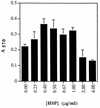Subcellular localization and cytotoxic activity of the GroEL-like protein isolated from Actinobacillus actinomycetemcomitans
- PMID: 9784537
- PMCID: PMC108663
- DOI: 10.1128/IAI.66.11.5307-5313.1998
Subcellular localization and cytotoxic activity of the GroEL-like protein isolated from Actinobacillus actinomycetemcomitans
Abstract
The subcellular locations, ultrastructure, and cytotoxic activity of the GroEL-like protein from Actinobacillus actinomycetemcomitans were investigated. Two-dimensional sodium dodecyl sulfate-polyacrylamide gel electrophoresis (SDS-PAGE) clearly indicated that synthesis of the GroEL-like protein is substantially increased after a thermal shock. Analysis of the purified native GroEL-like protein by transmission electron microscopy revealed the typical 14-mer cylindrical molecule, which had a diameter of about 12 nm. A. actinomycetemcomitans cells grown at 35 degreesC and heat shocked at 43 degreesC were fractionated, and fractions were separated by SDS-PAGE and analyzed by Western immunoblotting using antibodies to GroEL- and DnaK-like proteins. The GroEL-like protein was found in both the soluble and membrane fractions, whereas the DnaK-like protein was mostly found in the cytoplasm. An increase in specific proteins, including the GroEL- and DnaK-like proteins, was found in heat-shocked cells. The subcellular localization of the GroEL-like protein was examined by immunoelectron microscopy of whole cells. More GroEL-like protein was detected in stressed cells than in unstressed cells, and most of it was found not directly associated with outer membranes but rather in extracellular material. The native GroEL-like protein was assessed for cytotoxic activities. The GroEL-like protein increased the proliferation of periodontal ligament epithelial cells at concentrations between 0.4 and 1.0 microgram/ml. The number of cells in the culture decreased significantly at higher concentrations. A cell viability assay using HaCaT epithelial cells indicated that the GroEL-like protein was strongly toxic for the cells. These studies suggest the extracellular nature of the GroEL-like protein and its putative role in disease initiation.
Figures





Similar articles
-
Localization of heat shock proteins in clinical Actinobacillus actinomycetemcomitans strains and their effects on epithelial cell proliferation.FEMS Microbiol Lett. 2000 Jan 15;182(2):231-5. doi: 10.1111/j.1574-6968.2000.tb08900.x. FEMS Microbiol Lett. 2000. PMID: 10620671
-
Heat shock response in Actinobacillus actinomycetemcomitans.FEMS Immunol Med Microbiol. 1994 May;8(4):321-8. doi: 10.1111/j.1574-695X.1994.tb00459.x. FEMS Immunol Med Microbiol. 1994. PMID: 7914792
-
Antigenic cross-reactivity and sequence homology between Actinobacillus actinomycetemcomitans GroEL protein and human fibronectin.Oral Microbiol Immunol. 2004 Apr;19(2):124-8. doi: 10.1111/j.0902-0055.2003.00125.x. Oral Microbiol Immunol. 2004. PMID: 14871354
-
Bacterial Heat Shock Protein GroEL (Hsp64) Exerts Immunoregulatory Effects on T Cells by Utilizing Apoptosis.PLoS One. 2016 Oct 13;11(10):e0164380. doi: 10.1371/journal.pone.0164380. eCollection 2016. PLoS One. 2016. PMID: 27736933 Free PMC article.
-
Virulence factors of Actinobacillus actinomycetemcomitans.Periodontol 2000. 1999 Jun;20:136-67. doi: 10.1111/j.1600-0757.1999.tb00161.x. Periodontol 2000. 1999. PMID: 10522226 Review.
Cited by
-
Nonspecific adherence by Actinobacillus actinomycetemcomitans requires genes widespread in bacteria and archaea.J Bacteriol. 2000 Nov;182(21):6169-76. doi: 10.1128/JB.182.21.6169-6176.2000. J Bacteriol. 2000. PMID: 11029439 Free PMC article.
-
Stress wars: the direct role of host and bacterial molecular chaperones in bacterial infection.Infect Immun. 2006 Jul;74(7):3693-706. doi: 10.1128/IAI.01882-05. Infect Immun. 2006. PMID: 16790742 Free PMC article. Review. No abstract available.
-
The Functional Differences between the GroEL Chaperonin of Escherichia coli and the HtpB Chaperonin of Legionella pneumophila Can Be Mapped to Specific Amino Acid Residues.Biomolecules. 2021 Dec 31;12(1):59. doi: 10.3390/biom12010059. Biomolecules. 2021. PMID: 35053207 Free PMC article.
-
Proteomic Analysis and Virulence Assessment of Granulicatella adiacens Secretome.Front Cell Infect Microbiol. 2019 Apr 24;9:104. doi: 10.3389/fcimb.2019.00104. eCollection 2019. Front Cell Infect Microbiol. 2019. PMID: 31069174 Free PMC article.
-
Physical Features of Intracellular Proteins that Moonlight on the Cell Surface.PLoS One. 2015 Jun 25;10(6):e0130575. doi: 10.1371/journal.pone.0130575. eCollection 2015. PLoS One. 2015. PMID: 26110848 Free PMC article.
References
-
- Brunette D M, Melcher A H, Moe H K. Culture and origin of epithelium-like and fibroblast-like cells from porcine periodontal ligament explants and cell suspensions. Arch Oral Biol. 1976;21:393–400. - PubMed
-
- Ebersole J L, Cappelli D, Steffen M J. Longitudinal dynamics of infection and serum antibody in A. actinomycetemcomitans periodontitis. Oral Dis. 1995;1:129–138. - PubMed
Publication types
MeSH terms
Substances
LinkOut - more resources
Full Text Sources
Other Literature Sources
Molecular Biology Databases
Research Materials
Miscellaneous

